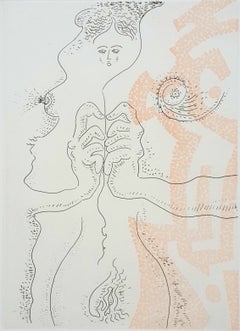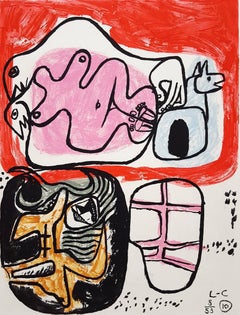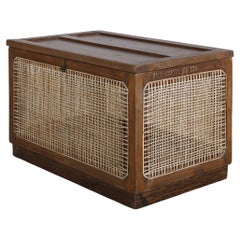Hayter Ariadne
1970s Surrealist Nude Prints
Etching, Intaglio, Aquatint
People Also Browsed
1960s Surrealist Nude Prints
Etching, Aquatint, Intaglio
Vintage 1950s Indian Mid-Century Modern Blanket Chests
Teak, Cane
20th Century Surrealist Abstract Prints
Lithograph, Offset
1940s American Modern Figurative Prints
Lithograph
1970s Contemporary Nude Prints
Lithograph
1910s American Impressionist Figurative Prints
Drypoint, Aquatint
1950s Surrealist Interior Prints
Etching, Aquatint, Intaglio
1910s American Impressionist Figurative Prints
Etching
20th Century Surrealist Abstract Prints
Lithograph
20th Century Surrealist Abstract Prints
Lithograph, Offset
Vintage 1960s Indian Mid-Century Modern Blanket Chests
Cane, Teak
20th Century Surrealist Abstract Prints
Lithograph
1910s American Impressionist Nude Prints
Etching, Aquatint
20th Century Surrealist Abstract Prints
Lithograph
1960s Surrealist Animal Prints
Etching, Aquatint, Intaglio
1910s American Impressionist Figurative Prints
Etching, Aquatint
André Masson for sale on 1stDibs
Born in 1896 in Balagny-sur- Thérain, a small village in France, André Masson spent most of his youth in Brussels, Belgium working as a pattern maker at an embroidery atelier. Masson began his schooling in 1907 at the Académie Royale des Beaux-Arts in Brussels. In 1912, he relocated to Paris, where he attended the École des Beaux-Arts. In 1914, the artist was called to military duty for the First World War, where he was severely wounded and sent back to Paris. Much of Masson’s work is influenced by this trauma; his drawings and paintings executed during the 1920s represent battle scenes, blood, death, birds and fish. The strange realities of trench warfare and the immediate contiguity of life and death are drawn upon, and his imagery suggests a confrontation of life at an abnormal level of experience. His signature style deals with violence, evident in terrifying, fragmented figures, which reflect the horrors of the Spanish Civil War and WWII, as well as his troubled psyche in the aftermath of his service in WWI.
After WWI, Masson moved to the South of France, where he met Juan Gris, André Derain, Joan Miró and André Breton. Breton championed the Surrealist Manifesto and Masson joined in the group exhibition of the first Surrealists. An iconoclast, whose abrupt stylistic transitions defy classification, Masson also explored automatism (automatic drawing), a process that sought to express the creative force of the unconscious. These automatic drawings had no preconceived subject or composition. Like a medium channeling a spirit, Masson let his pen travel rapidly across the paper without conscious control. He soon found hints of images, fragmented bodies and objects, emerging from the abstract, lacelike web of pen marks. At times, Masson elaborated on these with conscious changes or additions, but he left the traces of the rapidly drawn ink mostly intact. Masson’s oeuvre explores several techniques of painting, drawing and sculpture and displays rich, colorful abstraction as well as monochrome imagery and automatic linear representations. An early Surrealist and student of Cubism, Masson went on to inspire the New York Abstract Expressionists. Masson developed a technique of automatic painting that retained the element of chance; he dripped glue onto paper to form drawings and then covered it with sand. These ‘sand paintings’ are unquestionably his most iconic style.
When Masson emigrated to the U.S. in 1939, he strongly influenced several American painters with this technique, the most evident example being Jackson Pollack. After his time in America, he returned to Europe and while living in Spain during the mid-1930s, he became enraptured with Spanish themes—bullfights, matadors and Spanish mythology. Masson finally settled down in France (Aix-en-Provence), where he took up a late interest in impressionistic landscape, but he ultimately came to a place where he painted nearly exclusively abstract images. Masson dedicated his life as an artist to encouraging the non-rational purpose in art, to the direct transference of subconscious thought and to the primal forces of conflicts that he experienced in the trenches of World War One. Masson sought to convey in his work a deeper reality of man’s behavior, his own complex personal imagery, and his belief that painting is not a matter of developing style but a part of life itself.
A Close Look at surrealist Art
In the wake of World War I’s ravaging of Europe, artists delved into the unconscious mind to confront and grapple with this reality. Poet and critic André Breton, a leader of the Surrealist movement who authored the 1924 Surrealist Manifesto, called this approach “a violent reaction against the impoverishment and sterility of thought processes that resulted from centuries of rationalism.” Surrealist art emerged in the 1920s with dreamlike and uncanny imagery guided by a variety of techniques such as automatic drawing, which can be likened to a stream of consciousness, to channel psychological experiences.
Although Surrealism was a groundbreaking approach for European art, its practitioners were inspired by Indigenous art and ancient mysticism for reenvisioning how sculptures, paintings, prints, performance art and more could respond to the unsettled world around them.
Surrealist artists were also informed by the Dada movement, which originated in 1916 Zurich and embraced absurdity over the logic that had propelled modernity into violence. Some of the Surrealists had witnessed this firsthand, such as Max Ernst, who served in the trenches during World War I, and Salvador Dalí, whose otherworldly paintings and other work responded to the dawning civil war in Spain.
Other key artists associated with the revolutionary art and literary movement included Man Ray, Joan Miró, René Magritte, Yves Tanguy, Frida Kahlo and Meret Oppenheim, all of whom had a distinct perspective on reimagining reality and freeing the unconscious mind from the conventions and restrictions of rational thought. Pablo Picasso showed some of his works in “La Peinture Surréaliste” — the first collective exhibition of Surrealist painting — which opened at Paris’s Galerie Pierre in November of 1925. (Although Magritte is best known as one of the visual Surrealist movement’s most talented practitioners, his famous 1943 painting, The Fifth Season, can be interpreted as a formal break from Surrealism.)
The outbreak of World War II led many in the movement to flee Europe for the Americas, further spreading Surrealism abroad. Generations of modern and contemporary artists were subsequently influenced by the richly symbolic and unearthly imagery of Surrealism, from Joseph Cornell to Arshile Gorky.
Find a collection of original Surrealist paintings, sculptures, prints and multiples and more art on 1stDibs.
Finding the Right prints-works-on-paper for You
Decorating with fine art prints — whether they’re figurative prints, abstract prints or another variety — has always been a practical way of bringing a space to life as well as bringing works by an artist you love into your home.
Pursued in the 1960s and ’70s, largely by Pop artists drawn to its associations with mass production, advertising, packaging and seriality, as well as those challenging the primacy of the Abstract Expressionist brushstroke, printmaking was embraced in the 1980s by painters and conceptual artists ranging from David Salle and Elizabeth Murray to Adrian Piper and Sherrie Levine.
Printmaking is the transfer of an image from one surface to another. An artist takes a material like stone, metal, wood or wax, carves, incises, draws or otherwise marks it with an image, inks or paints it and then transfers the image to a piece of paper or other material.
Fine art prints are frequently confused with their more commercial counterparts. After all, our closest connection to the printed image is through mass-produced newspapers, magazines and books, and many people don’t realize that even though prints are editions, they start with an original image created by an artist with the intent of reproducing it in a small batch. Fine art prints are created in strictly limited editions — 20 or 30 or maybe 50 — and are always based on an image created specifically to be made into an edition.
Many people think of revered Dutch artist Rembrandt as a painter but may not know that he was a printmaker as well. His prints have been preserved in time along with the work of other celebrated printmakers such as Pablo Picasso, Salvador Dalí and Andy Warhol. These fine art prints are still highly sought after by collectors.
“It’s another tool in the artist’s toolbox, just like painting or sculpture or anything else that an artist uses in the service of mark making or expressing him- or herself,” says International Fine Print Dealers Association (IFPDA) vice president Betsy Senior, of New York’s Betsy Senior Fine Art, Inc.
Because artist’s editions tend to be more affordable and available than his or her unique works, they’re more accessible and can be a great opportunity to bring a variety of colors, textures and shapes into a space.
For tight corners, select small fine art prints as opposed to the oversized bold piece you’ll hang as a focal point in the dining area. But be careful not to choose something that is too big for your space. And feel free to lean into it if need be — not every work needs picture-hanging hooks. Leaning a larger fine art print against the wall behind a bookcase can add a stylish installation-type dynamic to your living room. (Read more about how to arrange wall art here.)
Find fine art prints for sale on 1stDibs today.


